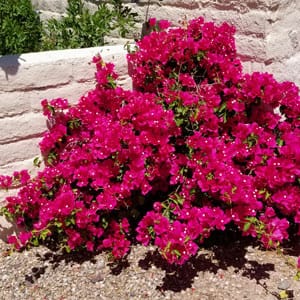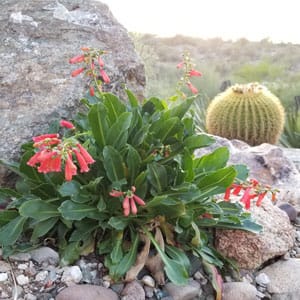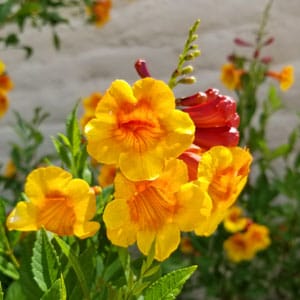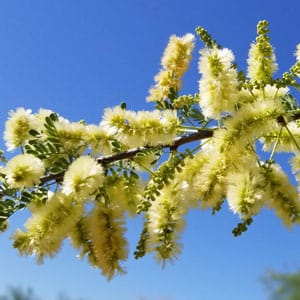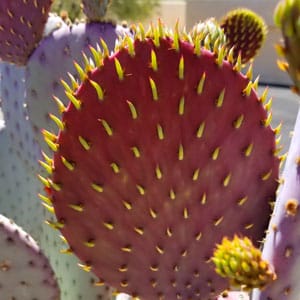Cactus & Succulents
Trees
Many people think that "desert" means "treeless" - but that's far from the case in Tucson!
It is always recommended to consider planting native trees over non-native. Native trees are better able to cope with the local environmental conditions of the area and typically require less attention than non-natives. They also serve as wildlife habitat for local animals, and are more resistant to harmful pests.
Trees Native to Arizona (below 4,500 feet)
- velvet mesquite (Prosopis velutina)
- screwbean mesquite (Prosopis pubescens)
- desert ironwood (Olneya tesota)
- cat claw acacia (Acacia greggii)
- white thorn acacia (Acacia constricta)
- netleaf hackberry (Celtis laevigata var. reticulata)
- foothills palo verde (Parkinsonia microphylla)
- blue palo verde (Parkinsonia florida)
- desert willow (Chilopsis linearis)
Trees Native to Arizona (between 4,500 feet and 6,000 feet)
- boxelder maple (Acer negundo)
- water birch (Betula occidentalis)
- netleaf hackberry (Celtis laevigata var. reticulate)
- western redbud (Cercis orbiculata)
- Arizona cypress (Cupressus arizonica)
- singleleaf ash (Fraxinus anomala)
- Arizona ash (Fraxinus velutina)
- Arizona walnut (Juglans major)
- alligator juniper (Juniperus deppeana)
- one-seed juniper (Juniperus monosperma)
- pinyon pine (Pinus edulis)
- Arizona sycamore (Platanus wrightii)
- Fremont cottonwood (Populus fremontii)
- chokecherry (Prunus virginiana)
- Emory oak (Quercus emoryi)
- Gambel oak (Quercus gambelii)
- shrub live oak (Quercus turbinella)
- Goodding’s willow (Salix gooddingii)
Trees Native to Arizona (above 6,000 feet)
- boxelder (Acer negundo)
- alligator juniper (Juniperus deppeana)
- Rocky Mountain juniper (Juniperus scopulorum)
- blue spruce (Picea pungens)
- pinyon pine (Pinus edulis)
- ponderosa pine (Pinus ponderosa)
- narrowleaf cottonwood (Populus angustifolia)
- chokecherry (Prunus virginiana)
- Gambel oak (Quercus gambelii)
- black locust (Robinia pseudoacacia)
- white fir (Abies concolor)
- flowering crabapple (Malus sp.)
- quaking aspen (Populus tremuloides)
- New Mexico locust (Robinia neomexicana)
For optimum fruit production in the low desert, choose deciduous fruit tree varieties that have low “chilling requirements,” early maturing fruit, and are self-pollinating.
The link below, from the U of A Cooperative Extension Service, has a list of low-chill deciduous fruit trees that should do well in the low desert and are available at local nurseries. It's not an all-inclusive list and many of these varieties are still untested in the low desert of Arizona, but it's an excellent starting point for choosing the best fruit and nut trees for your yard.
An online guide from Tucson Clean and Beautiful showing where and how to plant a tree, a watering guide, and tree pruning tips.
This series of videos was created by the Arizona Community Tree Council for AZ residents. The information presented is specific to our part of the country, rather than the generic advice usually found online that simply doesn't apply here in the desert.
This is a free service that marks existing utility lines so you don’t hit them!
If you’re planning to dig for any reason, you must contact Arizona 811 so underground utilities are located and marked in advance. Contacting Arizona 811 is easy and free. Call 811 or create a ticket online with E-Stake.
Whether you own or rent your home, Arizona law requires you to notify Arizona 811 at least two full working days (excluding weekends and state-recognized holidays) before you start any project, such as planting a tree, installing a fence or other projects that require any type of excavation.
Even shallow-depth projects can impact telecommunication, electric and gas distribution lines or other underground facilities — and put you and others at risk for serious injury.
For full details, FAQs and the online form, visit the Arizona 811 website.
Wildflowers In & Around Tucson
The Tucson area is home to many beautiful wildflowers that support our native birds, butterflies, insects and other wildlife. Many are easy to grow from seed or can be purchased as seedlings or plants. But please, leave wild wildflowers where you find them.
Want to know what's blooming in the Tucson area? This website has wildflower bloom reports submitted by local residents. It includes photos of what's in bloom, as well as details on where to find them.
This site shows photos and detailed descriptions of some of the most common southeastern Arizona wildflowers found around Tucson. These are the flowering plants that you are most likely to see because of their abundance, wide dispersal, long or multiple blooming seasons, plant prominence and distinctiveness.
Arizona has some of America's most varied habitat for wildflowers. This site showcases wildflowers found throughout the state, with complete descriptions and photo galleries.
This online guide is perfect for those curious about wildflowers and natural vegetation in the southwest, primarily Arizona. This site includes photographs and detailed descriptions of beautiful and sometimes rare plants that have adapted to and thrive under harsh conditions typical of North America deserts and transition areas.
The plants included in the site are either native, endemic, or invasive to one or more of the four major deserts in southwest North America which include the Sonoran, Chihuahuan, Mojave and the Great Basin. Also included are profiles for plants found in desert transition areas or higher elevation species found in neighboring upland and mountain areas. Transition and other habitat types are often encountered when hiking trails or spending time exploring southwest wild areas.
You can search for plants by color, name (both common and scientific), and type.
The site is always being updated with more photos and plant information.
This website describes the progression of spring and summer wildflower bloom for average years near Tucson. It may be three weeks earlier or later depending on weather, elevation, and latitude.
Weeds & Invasive Plants
While noxious weeds of any kind are not good to have in your Tucson garden, some are worse than others.
The AZ Department of Agriculture breaks plants into three categories of weeds; regulated pests, restricted pests, and prohibited noxious weeds. These categories apply to specific plant species and include any viable plant parts, such as stolons, rhizomes, cuttings, and seed (except agricultural, vegetable and ornamental seed for planting purposes).
Regulated Pests
If you find any of these regulated pest plants on your property, remove or otherwise control them (e.g., cut off flowers before they go to seed) to prevent them from spreading.
- Cenchrus echinatus -- Southern sandbur
- Cenchrus incertus -- Field sandbur
- Convolvulus arvensis -- Field bindweed
- Eichhornia crassipes -- Floating water hyacinth
- Medicago polymorpha -- Burclover
- Pennisetum ciliare -- Buffelgrass
- Portulaca oleracea -- Common purslane
- Tribulus terrestris -- Puncturevine
Restricted Pests
Any restricted pest plants found within Arizona should be “quarantined” to prevent further infestation or contamination.
- Acroptilon repens -- Russian knapweed
- Aegilops cylindrica -- Jointed goatgrass
- Alhagi pseudalhagi -- Camelthorn
- Cardaria draba -- Globed-podded hoary cress (Whitetop)
- Centaurea diffusa -- Diffuse knapweed
- Centaurea maculosa -- Spotted knapweed
- Centaurea solstitialis -- Yellow starthistle (St. Barnaby’s thistle)
- Cuscuta spp. -- Dodder
- Eichhornia crassipes -- Floating water hyacinth
- Elytrigia repens -- Quackgrass
- Euryops sunbcarnosus subsp. vulgaris -- Sweet resinbush
- Halogeton glomeratus -- Halogeton
- Helianthus ciliaris -- Texas blueweed
- Ipomoea triloba -- Three-lobed morning glory
- Linaria genistifolia var. dalmatica -- Dalmation toadflax (this is not the same plant as Linaria maroccana, Moroccan toadflax, which is a naturalized plant here in southeastern AZ)
- Onopordum acanthium -- Scotch thistle
Prohibited Noxious Weeds (R3-4-245)
These plants are prohibited from entering the state. Don’t plant, transplant, transport, sell, buy or propagate them. Basically, if you see one of these, destroy it.
- Acroptilon repens -- Russian knapweed
- Aegilops cylindrica -- Jointed goatgrass
- Alhagi pseudalhagi -- Camelthorn
- Alternanthera philoxeroides -- Alligator weed
- Cardaria pubescens ‑‑ Hairy whitetop
- Cardaria chalepensis ‑‑ Lens podded hoary cress
- Cardaria draba -- Globed-podded hoary cress (Whitetop)
- Carduus acanthoides -- Plumeless thistle
- Cenchrus echinatus -- Southern sandbur
- Cenchrus incertus -- Field sandbur
- Centaurea calcitrapa ‑‑ Purple starthistle
- Centaurea iberica -- Iberian starthistle
- Centaurea squarrosa -- Squarrose knapweed
- Centaurea sulphurea -- Sicilian starthistle
- Centaurea solstitialis -- Yellow starthistle (St. Barnaby’s thistle)
- Centaurea diffusa -- Diffuse knapweed
- Centaurea maculosa -- Spotted knapweed
- Chondrilla juncea -- Rush skeletonweed
- Cirsium arvense ‑‑ Canada thistle
- Convolvulus arvensis -- Field bindweed
- Coronopus squamatus -- Creeping wartcress (Coronopus)
- Cucumis melo L. var. Dudaim Naudin ‑‑ Dudaim melon (Queen Anne’s melon)
- Cuscuta spp. -- Dodder
- Drymaria arenarioides ‑‑ Alfombrilla (Lightningweed)
- Eichhornia azurea ‑‑ Anchored water hyacinth
- Eichhornia crassipes – Floating water hyacinth
- Elytrigia repens -- Quackgrass
- Euphorbia esula -- Leafy spurge
- Halogeton glomeratus -- Halogeton
- Helianthus ciliaris -- Texas blueweed
- Hydrilla verticillata ‑‑ Hydrilla (Florida-elodea)
- Ipomoea spp. ‑‑ Morning glory. All species except Ipomoea carnea, Mexican bush morning glory; Ipomoea triloba, three-lobed morning glory (which is considered a restricted pest); and Ipomoea aborescens, morning glory tree
- Isatis tinctoria -- Dyers woad
- Lythrum salicaria -- Purple loosestrife
- Nassella trichotoma -- Serrated tussock
- Orobanche ramosa -- Branched broomrape
- Panicum repens -- Torpedo grass
- Peganum harmala -- African rue (Syrian rue)
- Pennisetum ciliare – Buffelgrass,
- Portulaca oleracea -- Common purslane
- Rorippa austriaca ‑‑ Austrian fieldcress
- Salvinia molesta -- Giant Salvinia
- Senecio jacobaea -- Tansy ragwort
- Solanum carolinense ‑‑ Carolina horsenettle
- Sonchus arvensis ‑‑ Perennial sowthistle
- Solanum viarum -- Tropical Soda Apple
- Stipa brachychaeta. -- Puna grass
- Striga spp. -- Witchweed
- Trapa natans -- Water-chestnut
The species profiles shared by the EUSDA provide general information about species considered to be invasive. It's not a list of all invasive species, nor does the information have regulatory implications (just because a plant is on the list doesn't mean that states or cities must take action to prevent its spread). There are so many invasive plant species across the country that the USDA can't maintain detailed information on ALL invasive species, so use this list as a starting point for educational purposes. In addition, determining the invasiveness of a species depends on a number of local factors, including type of habitat.
The Tucson area is pretty unique so while a plant may appear on the USDA list of invasive plants, it may not actually be invasive here.
The following species have been listed on an invasive species list or noxious weed law in North America. For more information on each species, including the listing sources, images, and publication links, click on the species.
>> Invasive.org
This database of photos, published by the University of Arizona Cooperative Extension, has tons of weed photos to help you identify them.
The University of California's Weed Research and Information Center has a fantastic website to help you identify weed plants. It asks a bunch of questions, including which state you're in (so the results you see will be applicable to Tucson), and then suggests the most likely candidates (with photos). The more detail you can provide, the better the result.
Tucson Resources
You won't want to miss this!
TUCSON YARD & GARDEN TIPS, HOW-TO'S, EVENTS, COUPONS AND MORE
No spam - we promise! Just helpful yard and garden info specifically for Tucson residents.
